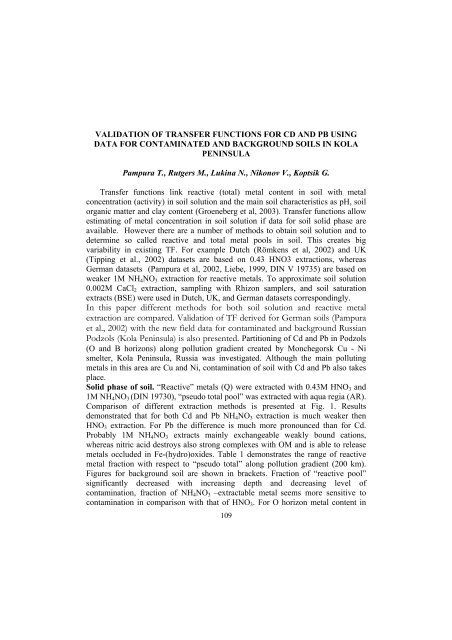C - Lublin
C - Lublin
C - Lublin
You also want an ePaper? Increase the reach of your titles
YUMPU automatically turns print PDFs into web optimized ePapers that Google loves.
VALIDATION OF TRANSFER FUNCTIONS FOR CD AND PB USING<br />
DATA FOR CONTAMINATED AND BACKGROUND SOILS IN KOLA<br />
PENINSULA<br />
Pampura T., Rutgers M., Lukina N., Nikonov V., Koptsik G.<br />
Transfer functions link reactive (total) metal content in soil with metal<br />
concentration (activity) in soil solution and the main soil characteristics as pH, soil<br />
organic matter and clay content (Groeneberg et al, 2003). Transfer functions allow<br />
estimating of metal concentration in soil solution if data for soil solid phase are<br />
available. However there are a number of methods to obtain soil solution and to<br />
determine so called reactive and total metal pools in soil. This creates big<br />
variability in existing TF. For example Dutch (Römkens et al, 2002) and UK<br />
(Tipping et al., 2002) datasets are based on 0.43 HNO3 extractions, whereas<br />
German datasets (Pampura et al, 2002, Liebe, 1999, DIN V 19735) are based on<br />
weaker 1M NH 4 NO 3 extraction for reactive metals. To approximate soil solution<br />
0.002M CaCl 2 extraction, sampling with Rhizon samplers, and soil saturation<br />
extracts (BSE) were used in Dutch, UK, and German datasets correspondingly.<br />
In this paper different methods for both soil solution and reactive metal<br />
extraction are compared. Validation of TF derived for German soils (Pampura<br />
et al., 2002) with the new field data for contaminated and background Russian<br />
Podzols (Kola Peninsula) is also presented. Partitioning of Cd and Pb in Podzols<br />
(O and B horizons) along pollution gradient created by Monchegorsk Cu - Ni<br />
smelter, Kola Peninsula, Russia was investigated. Although the main polluting<br />
metals in this area are Cu and Ni, contamination of soil with Cd and Pb also takes<br />
place.<br />
Solid phase of soil. “Reactive” metals (Q) were extracted with 0.43M HNO 3 and<br />
1M NH 4 NO 3 (DIN 19730), “pseudo total pool” was extracted with aqua regia (AR).<br />
Comparison of different extraction methods is presented at Fig. 1. Results<br />
demonstrated that for both Cd and Pb NH 4 NO 3 extraction is much weaker then<br />
HNO 3 extraction. For Pb the difference is much more pronounced than for Cd.<br />
Probably 1M NH 4 NO 3 extracts mainly exchangeable weakly bound cations,<br />
whereas nitric acid destroys also strong complexes with OM and is able to release<br />
metals occluded in Fe-(hydro)oxides. Table 1 demonstrates the range of reactive<br />
metal fraction with respect to “pseudo total” along pollution gradient (200 km).<br />
Figures for background soil are shown in brackets. Fraction of “reactive pool”<br />
significantly decreased with increasing depth and decreasing level of<br />
contamination, fraction of NH 4 NO 3 –extractable metal seems more sensitive to<br />
contamination in comparison with that of HNO 3 . For O horizon metal content in<br />
109
















